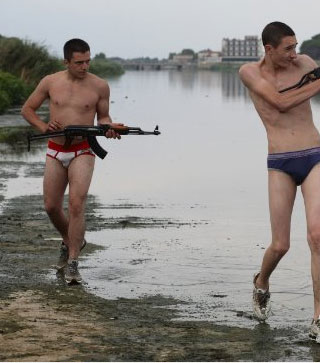Gomorrah
by George Sax
Little Ceasars
The deadly surprise attacks keep interrupting Gomorrah, virtually from start to finish. Ambushes are sprung from somewhere off-camera, surprising both us and the on-screen victims, even when we and they have increasing reason to expect the worst. This spasmodic violence doesn’t so much puncture Gomorrah’s rambling, multi-story narrative as lend a brutal continuity to it.

Matteo Garrone’s film is based on Roberto Saviano’s notorious “non-fiction novel” of the same title, published three years ago. (The author is one of six credited screenwriters, including the director.) This title is rather obviously intended to mimic the name of the organized crime network that controls a great deal of the economic and political activity in and around Naples, the Cammora. (Alexander Stille, a Columbia University journalism professor who has studied Italian society for years, recently wrote that the Mafia has been reliably estimated to control at least seven percent of Italy’s commerce.)
Gomorrah is set in Scampia, an economically depressed northern suburb of Naples. The filmmakers have compressed Saviano’s wide-ranging, first-person investigation of the Cammora and extracted five sketchy story lines. The film’s intermittent observations of four of these are confined to one hardscrabble town, and a large, grimly looming, Soviet-style housing project in particular. The fifth ranges further, geographically and sociologically, venturing as far as Venice.
It centers on Franco (Toni Servillo), a confident, middle-aged commercial type who strikes deals and oversees the operations of a gang-controlled waste management enterprise. Franco doesn’t seem to be involved in the persistent internecine violence that marks so many of the other characters in Gomorrah, but metaphorically, his hands are hardly clean. The dapper operator’s business efforts are bent toward depositing chemical waste around the Naples-dominated Campania region, anyplace he can secure permission, legally or not. (Naples and the surrounding region have an alarmingly elevated incidence of cancer and other environmentally influenced illnesses.) What seems an escape from Scandia’s degraded hopelessness to Roberto (Carmine Paternoster), a recent university grad whom Franco hires as an assistant, is both more and less than he expected.
Back in the projects, the attention of Toto (Salvatore Abruzzese), a boy of 12, is diverted from his grocery delivery chores to the more alluring work of the local gang.
These and other characters’ pursuits aren’t closely tracked; they’re each periodically glimpsed before Gomorrah abruptly moves on to someone else. Garrone has, in his own words, chosen to put his film together “as if I were a passerby who happened to find myself there by chance.” And he says he worked to avoid taking sides, although in two instances he seems to ignore his own rule.
Saviono’s book has been immensely popular in Italy, and Garrone’s film has been a popular success there and a critical one in this country, but it’s almost certainly going to mean a lot less to Americans, literally. It helps to bring a minimum amount of information to Gomorrah to understand, for instance, that unlike Sicily’s mafia, Campania’s is less hierarchical, a loosely knit confederation of clannish, locally focused gangs. Even so, it’s difficult to connect the squalid milieu and petty-minded thugs of the movie with an underworld that’s said to control much of the import transactions in the port of Naples and to have its tentacles in the fashion, construction, food distribution and other industries.
The Village Voice’s J. Hoberman has written that Gomorrah’s appeal is limited by its “tunnel vision,” and he has a point. What Garrone seems to have attempted is to create his version of an Italian Neorealist film, in the fashion of the famous post-war work of film artists like DeSica and Rossellini. He’s got the dismally real settings and on-location filming, the focus on members of society’s oppressed, the partial use of non-professional performers (three of whom have been arrested since the film was completed). But there are important elements absent.
The slowly building dramatic tension, the essential human insights and sympathy of the earlier work are only briefly and incidentally present in Gomorrah. Garrone has achieved a flattened affect and dramatic tone. The “I am a camera” evenhandedness vitiates an audience’s ability to become involved with the characters and events. In a way, Garrone has been too successful.
Watch the movie trailer for Gomorrah
blog comments powered by Disqus
|
Issue Navigation> Issue Index > v8n13 (week of Thursday, March 26, 2009) > Film Reviews > Gomorrah This Week's Issue • Artvoice Daily • Artvoice TV • Events Calendar • Classifieds |









 Current Issue
Current Issue